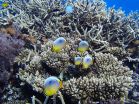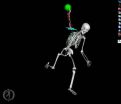(Press-News.org) In the first results to emerge from HIV patient trials of a new generation of so-called broadly neutralizing antibodies, Rockefeller University researchers have found the experimental therapy can dramatically reduce the amount of virus present in a patient's blood. The work, reported this week in Nature, brings fresh optimism to the field of HIV immunotherapy and suggests new strategies for fighting or even preventing HIV infection.
In a person infected with HIV, there is an ongoing arms race between the virus and the body's immune system. Even as the body produces new antibodies that target the virus, the virus is constantly mutating to escape, managing to stay just a few steps ahead. The new study, conducted in Michel Nussenzweig's Laboratory of Molecular Immunology, finds that administration of a potent antibody, called 3BNC117, can catch HIV off guard and reduce viral loads.
HIV antibodies previously tested in humans had shown disappointing results. 3BNC117 belongs to a new generation of broadly neutralizing antibodies that potently fight a wide range of HIV strains. "What's special about these antibodies is that they have activity against over 80 percent of HIV strains and they are extremely potent," says Marina Caskey, assistant professor of clinical investigation in the Nussenzweig lab and co-first author of the study. 3BN117, which was originally isolated by Johannes Scheid in the Nussenzweig laboratory, targets the CD4 binding site of the HIV envelope, and the CD4 receptor is the primary site of attachment of HIV to host cells, 3BNC117 shows activity against 195 out of 237 HIV strains.
Broadly neutralizing antibodies are produced naturally in some 10 to 30 percent of people with HIV, but only after several years of infection. By that time the virus in their bodies has typically evolved to escape even these powerful antibodies.
However, by isolating and then cloning these antibodies, researchers are able to harness them as therapeutic agents against HIV infections that have had less time to prepare. Earlier work in the Nussenzweig lab had demonstrated that these potent antibodies could prevent or suppress infection in mouse and non-human primate models of HIV. But these animal models are very rough approximations of human infections, explains Caskey. The mice must be genetically engineered to be susceptible to HIV and therefore lack an intact immune system, and the primates used in HIV studies can only be infected with a simian version of the virus. The proof of principle awaited human trials.
In the new study, uninfected and HIV-infected individuals were intravenously given a single dose of the antibody and monitored for 56 days. At the highest dosage level tested in the study, 30 milligrams per kilogram of weight, all eight infected individuals treated showed up to 300-fold decreases in the amount of virus measured in their blood, with most reaching their lowest viral load one week after treatment. The drop in viral load depended on the individual's starting viral load and also the sensitivity of their particular strains of HIV to the antibody.
This is the first time that the new generation of HIV antibodies has been tested in humans. Not only was a single dose of 3BN117 well tolerated and effective in temporarily reducing viral loads, in some individuals it remained active in the body for a long time. In half of the individuals receiving the highest dose, viral loads remained below starting levels even at the end of the 8-week study period and resistance to 3BNC117 did not occur. Researchers also believe that antibodies may be able to enhance the patient's immune responses against HIV, which can in turn lead to better control of the infection. In addition, antibodies like 3BNC117 may be able to kill viruses hidden in infected cells, which serve as viral reservoirs inaccessible to current antiretroviral drugs.
Most likely, 3BNC117, like other anti-retrovirals, will need to be used in combination with other antibodies or antiretroviral drugs to keep infections under control. "One antibody alone, like one drug alone, will not be sufficient to suppress viral load for a long time because resistance will arise," says Caskey. One important benefit is the dosing schedule: an antibody therapy for HIV might require treatment just once every few months, compared to daily regimens of antiretroviral drugs that are now the front-line treatment for HIV.
"In contrast to conventional antiretroviral therapy, antibody-mediated therapy can also engage the patient's immune cells, which can help to better neutralize the virus," says co-first author Florian Klein, also assistant professor of clinical investigation in the Nussenzweig laboratory.
Besides the possibility of treatment, the study also raises hopes for an HIV vaccine. If researchers can induce an uninfected person's immune system to generate potent antibodies such as 3BNC117, it might be enough to block the HIV infection before it can be established.
Ongoing clinical research in Nussenzweig's lab and The Rockefeller University Hospital aims to address the impact of additional broadly neutralizing antibodies, alone or in combination, on viral load in HIV-infected patients.
INFORMATION:
Dr. Nussenzweig is Zanvil A. Cohn and Ralph M. Steinman Professor as well as a Howard Hughes Medical Institute investigator; the research received funding from the Robertson Fund at Rockefeller, a Clinical and Translational Science Award from the National Center for Research Resources of the National Institutes of Health, and the Bill and Melinda Gates Foundation.
In a feat that would have been unachievable only a few years ago, researchers at UC San Francisco have pulled aside the curtain on a protein informally known as the "wasabi receptor," revealing at near-atomic resolution structures that could be targeted with anti-inflammatory pain drugs.
Officially named TRPA1 (pronounced "trip A1"), the newly visualized protein resides in the cellular membrane of sensory nerve cells. It detects certain chemical agents originating outside our bodies--pungent irritants found in substances ranging from wasabi to tear gas--but is also triggered ...
A new scientific synthesis suggests a gradual, prolonged release of greenhouse gases from permafrost soils in Arctic and sub-Arctic regions, which may afford society more time to adapt to environmental changes, say scientists in an April 9 paper published in Nature.
"Twenty years ago there was very little research about the possible rate of permafrost carbon release," said co-author A. David McGuire, U.S. Geological Survey senior scientist and climate modeling expert with the Institute of Arctic Biology at the University of Alaska Fairbanks. "In 2011, we assembled an ...
Fish are the key ingredients in a new recipe to diagnose and restore degraded coral reef ecosystems, according to scientists from the Australian Institute of Marine Science, WCS, James Cook University, and other organizations in a new study in the journal Nature.
For overfished coral reef systems, restoring fish populations that perform key roles will in turn restore ecological functions critical to recovery. For moderately or lightly fished reefs, the recipe requires knowing which fish to catch, how many, and which to leave behind.
The authors assessed fish biomass ...
EVANSTON, Ill. --- A new approach to analyzing baseball-pitching biomechanics may one day give players more personalized feedback and help prevent elbow injuries.
In a computer simulation study of baseball pitching, Northwestern University biomedical engineers found that the strength of the elbow muscles of a baseball pitcher likely play a bigger role in injury risk and prevention than previously thought.
The motion analysis approach currently used in the baseball industry to provide athletes with injury-risk feedback is not sophisticated enough to estimate what an ...
April 8, 2015--Researchers at Columbia University's Mailman School of Public Health and Columbia Business School studied bed capacity --measured by the number of staffed beds -- in New York City hospital obstetrics units and found a significant excess number of beds, which overall cost the city an estimated $26.4 million each year. The findings, coupled with the current trends of an aging population and the declining birth rate, suggest that many obstetrics units could reduce their bed capacity and still assure timely access to care. Study findings are published in the ...
CAMBRIDGE, Mass--Biologists at MIT and the Whitehead Institute for Biomedical Research have discovered a vulnerability of brain cancer cells that could be exploited to develop more-effective drugs against brain tumors.
The study, led by researchers from the Whitehead Institute and MIT's Koch Institute for Integrative Cancer Research, found that a subset of glioblastoma tumor cells is dependent on a particular enzyme that breaks down the amino acid glycine. Without this enzyme, toxic metabolic byproducts build up inside the tumor cells, and they die.
Blocking this enzyme ...
BOSTON (April 8, 2015) -- A two-year epidemiological study of Puerto Rican adults with type 2 diabetes in the greater Boston area who were using insulin and lived next to roads with heavy traffic had markedly increased C-reactive protein, a marker of inflammation, compared to those living in lower traffic areas. Individuals taking oral diabetes medications did not experience increases in CRP concentration. The study, published online in Environmental Pollution, builds on the research team's previous work suggesting that oral diabetes medications may provide a protective ...
Since 2007, California has had one of the most aggressive incentive programs in the country for putting solar-electric panels on the rooftops of homes and businesses. Its $2.2 billion California Solar Initiative (CSI)has provided a per-watt rebate for installing residential and commercial photovoltaic systems. During this period, the solar industry in the state has experienced double-digit growth and to date has installed more than 245,000 systems capable of producing 2,365 megawatts of electricity.
As a result, CSI has been widely touted as a major success. However, ...
Numerous studies over the past 30 years have linked exposure to nature with improved human health and well-being. These findings are of growing importance: In the near future, 70% of the world's population will live in cities, where they will face a rising tide of lifestyle-related disease. Still, little is known about the mechanisms underlying the nature-health connection, and confusion awaits those who would transform existing findings into action.
In the June issue of BioScience, a group of biologists and public health experts led by Danielle F. Shanahan address this ...
The ceremonial opening kick of the 2014 FIFA World Cup in Sao Paolo, Brazil, which was performed--with the help of a brain-controlled exo-skeleton--by a local teen who had been paralyzed from the waste down due to a spinal cord injury, was a seminal moment for the area of neuroscience that strives to connect the brain with functional prosthetics. The public display was a representative of thousands of such neuroprosthetic advances in recent years, and the tens of years of brain research and technological development that have gone into them. And while this display was quite ...


